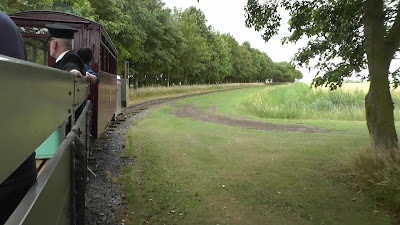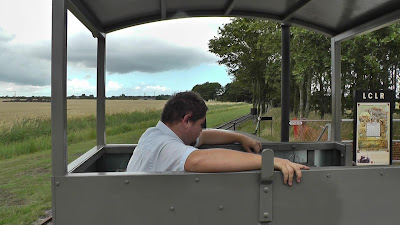 |
| Snap of Prince and Blanche at Tan-y-Bwlch in the mid 1960s |
Over the coming years I intend to visit (and re-visit) the sites of narrow gauge railways in the UK accessible to the public and record the outcome of my visits and researches. The outcome will no doubt be idiosyncratic and completely partial - I am, after all, only human!
The accepted definition of 'narrow gauge' includes railways with a gauge of less than 4' 8½". This should therefore include miniature railways. However, as there are nearly 500 railways in the UK which fit this description I have decided initially to concentrate on passenger carrying and commercial railways with a gauge between 12" and 4' 8½".
Below you will find a list of the railways which fit my parameters outlined above. I think I have listed the passenger carrying and commercial lines which have existed or do exist in the UK (with a gauge greater than 12") - however, I have found it is quite difficult to find a definitive list - railways seem to come and go at will. In addition, I have plotted all the railways on a Google Map, to help me plan my visits.
View Narrow Gauge Railways in a larger map
You will notice that this list has around fifty 'live' entries so far out of just over 200 possible railways. I am intending to start from scratch - visiting and revisiting each railway but, this time, being more systematic in the information, images and videos I collect.
- Abbey Pumping Station Museum (2')
- Alford & Sutton Tramway (2’ 6”) - closed 1889
- Amberley Museum (2')
- Amerton Railway (2')
- Apedale Valley Light Railway (2')
- Ashover Light Railway (1’11½”) (Closed 1950)
- Bicton Woodland Railway (1' 6")
- Billing Aquadrome Railway (15”)
- Black Country Museum Tramway (3' 6")
- Blackpool Zoo Miniature Railway (15")
- Blenheim Park Railway (15")
- Bredgar & Wormshill Light Railway (2')
- Bressingham Steam Museum (2', 15" )
- Bridgnorth Castle Hill Railway (3' 8½")
- Bure Valley Railway (15")
- Bursledon Brickworks Trust (2’)
- Buxton Pavilion Gardens Railway (12¼")
- Camborne and Redruth Tramways (3’6)
- Chasewater Narrow Gauge Railway (2')
- Cleethorpes Coast Light Railway (15”)
- Combe Martin Wildlife & Dinosaur Park (15")
- Conkers Express (2')
- Cotswold Wildlife Park (2’)
- Cricket St Thomas Lakes and Gardens (15")
- Derbyshire Dales Narrow Gauge Railway (2')
- Devon Railway Centre (2')
- Drayton Manor Park (2')
- Drusilla's Park (2')
- East Anglian Transport Museum (2')
- Eaton Railway (15")
- Ecclesbourne Valley Railway (2')
- Evesham Vale Light Railway (15")
- Exbury Gardens and Steam Railway (12¼")
- Fayles Tramway (3’9” - 1’ 11½” )
- Flamingoland (2', 1' 3")
- Gartell Light Railway (2')
- Golden Valley Light Railway (2')
- Great Bush Railway (2')
- Great Whipsnade Railway (2' 6")
- Great Woburn Railway (20")
- Gulliver's Kingdom – Lilliput Loco (1' 9½")
- Gulliver's Land - Gulliver’s Railroad (15")
- Gulliver's World – Gulliver’s Railroad (15")
- Haigh Hall Country Park Railway (15")
- Hampshire Narrow Gauge Railway Trust (Bursledon) (2')
- Hayling Seaside Railway (2’)
- Hampton & Kempton Waterworks Railway (2')
- Heatherslaw Light Railway (15")
- Herefordshire Water Works (2’)
- Hollycombe Steam Collection (2')
- Hopewell Colliery Museum (2')
- Hotham Park Miniature Railway (12¼")
- Hythe Pier Railway (2')
- Imperial War Museum (2')
- Irchester Narrow Gauge Railway (1m)
- Ironbridge - Blists Hill - Clay Mine Railway (2')
- J Nemeth Engineering (2')
- Kirklees Light Railway (15”)
- Knowsley Safari Park (15")
- Lakeside Miniature Railway - Southport (15")
- Lappa Valley Railway (15")
- Launceston Steam Railway (1’11½”)
- Lea Line (Alan Keef Ltd) (2', 3’6”)
- Leeds Industrial Museum (Various)
- Leek &Manifold Railway (2’ 6”)
- Legoland Express (2')
- Leighton Buzzard Narrow Gauge Railway (2')
- Lightwater Valley Theme Park (15")
- LincolnshireCoast Light Railway (60cm) (1’ 11 5/8”)
- Littlehampton Miniature Railway (12¼")
- London Funicular Railway (1m)
- London Museum of Steam & Water Waterworks Railway - Kew (2')
- Longleat Railway (15")
- Lynton &Barnstaple Railway (1’11½“)
- Lynton & Lynmouth Cliff Railway (3' 9")
- Marwells Wonderful Railway - Marwell Wildlife Park (15")
- Milky Way Railway (2')
- Morwellham Quay Copper Mine Tramway (61cm)
- Moseley Industrial Museum (2')
- National Coal Mining Museum (2' 6", 2' 3")
- National Railway Museum (2')
- Newchapel, Horne & Burstow Grand Junction Railway (12¼")
- North Bay Railway - Scarborough (20")
- North Ings Farm Museum and Railway (2')
- Old Kiln Light Railway (2')
- Paradise Park - Jungle Express (15")
- Paultons Park – Rio Grande Train (15")
- Perrygrove Railway (15")
- Phoenix Light Railway (2')
- Pleasure Beach Express (1' 9")
- Pleasure Island Railway (2')
- Pleasurewood Hills (2’)
- Poppleton Nursery (2')
- Purbeck Mining Museum (2')
- Ravenglass & Eskdale Railway (15")
- Ripon Light Railway (2')
- Romney, Hythe & Dymchurch Railway (15")
- Rosevale Mine (1’ 10¼“, 1’ 6”)
- Royal Gunpowder Mills (18", 2' 6")
- Ruislip Lido (12")
- Rye & Camber (3’)
- Saltburn Cliff Railway (4' 8½") (Not narrow gauge but worth a visit)
- Saltburn Miniature Railway (15")
- Seaton Tramway (2' 9")
- Shepreth Wildlife Park (40cm)
- Sherwood Forest Light Railway (15")
- Shipley Glen Tramway (1' 8")
- Sittingbourne& Kemsley Light Railway (2' 6")
- South Tynedale Light Railway (2')
- Southend Cliff Lift (4' 6")
- Southend Pier Railway (3')
-
Southwold Railway (3')
- Southport Pier Tramway (3' 6")
- St Michael's Mount (2' 5")
- Statfold Barn Railway (2' 6", 2')
- Steeple Grange Light Railway (1' 6")
- Strumpshaw Steam Museum (2')
- Sundown Adventureland (1' 6")
- Telford Steam Railway (2' (Steam tram))
- Threlkeld Mining Museum (2')
- Toddington Narrow Gauge Railway (2')
- Twinlakes Miniature Railway (15")
- Twyford Waterworks (2')
- Volk's Electric Railway (2' 8½")
- Wells and Walsingham Light Railway (10¼")
- West Lancashire Light Railway (2')
- West Midlands Safari Park (15")
- Westonzoyland Pumping Station (2')
- Wicksteed Park (2')
- Windmill Farm Railway (15")
- Wolverton & Stony Stratford Tramway (3’ 6”)
- Woodhorn Colliery Museum (2')
- Yaxham Light Railway (2')
- Anglesey Model Village (12")
- Bala Lake Railway (60cm)
- Brecon Mountain Railway (1' 11¾")
- Conwy Valley Railway Museum (15")
- Corris Railway (2' 3")
- Fairbourne Railway (12¼")
- Ffestiniog Railway (1' 11¾")
- Glyn Valley Tramway (2' 4½")
- Great Orme Tramway (3'6")
- Llanberis Lake Railway (1' 11½")
- Llechwedd Slate Caverns (1' 11½")
- Margam Park Railway (2')
- Oakwood Adventure Park (600mm, 15")
-
Penrhyn Quarry Railway (1’ 10¾”)
- Rhiw Valley Light Railway (15")
- Rhyl Miniature Railway (15")
- Snowdon Mountain Railway (2' 7½" (800mm))
- Talyllyn Railway (2' 3")
- Teifi Valley Railway (1' 11½")
- Vale of Rheidol Railway (1' 11¾")
- Welsh Highland Heritage Railway (1' 11½")
- Welsh Highland Railway (1' 11½")
- Welshpool & Llanfair Light Railway (2' 6")
Narrow Gauge Railways in Scotland
- Alford Valley Railway (2')
- Almond Valley Heritage Centre (2' 6")
-
Campbeltown and Machrihanish (2’3”)
- Clyde Valley Railway (2')
- Craigtoun Park Railway (15")
- East Links Railway (2')
- Glasgow Underground Railway (4')
- Leadhills & Wanlockhead Railway (2')
- Arigna Mines Experience (2')
- Ballymena, Cushendall & Red Bay (3’)
- Ballymena & Larne (3’)
- Ballycastle (3’)
- Castlerigg & Victoria Bridge Tramway (3’)
- Cavan & Leitrim Railway (3')
- Clogher Valley tramway (3’)
-
Cork, Blackrock & Passage (3’ (originally 5’3”))
- Cork & Muskerry Light Railway (3’)
- County Donegal Railway (3’3”)
- Difflin Lake Railway (15")
-
County Donegal (3’)
- Fintown & Glenties Railway (3')
- Giants Causeway & Bushmills Railway (3')
- Irish Steam Preservation Society (3')
- Lartigue Monorail and Museum (0')
- Leisureland Funworld Express (2')
- Londonderry & Lough Swilly (3’)
- Peatlands Park (3')
- Schull & Skibbereen (3’)
- Stradbally Railway (Railway Preservation Society of Ireland) (3')
- Sunshine Peat Co. (2' 6")
- Tralee & Blennerville Railway (3')
- Tralee & Dingle (3’)
- Tramore Miniature Railway (15")
- Waterford & Suir Valley Railway (3')
- West Clare Railway (3')
- West Clare (3’)
- Westport House (15")
Isle of Man
- Douglas Bay Horse Tramway (3')
- Great Laxey Mines Tramway (1' 7")
- Groudle Glen Railway (2')
- Isle of Man Steam Railway (3')
- Manx Electric Railway (3')
- Snaefell Mountain Railway (3' 6")
- Jersey Railway (3’6”)
- Pallot Steam Museum (2' ??)
Background research
To inform my visits I have been conducting more generalised background research on the history and development of narrow gauge railways in the UK and Ireland. From time to time I will share the outcome of my researches here:
- Progress Report 1 - October 2011 - Getting started
- Progress Report 2 - July 2012 - Mapping the railways
- Progress Report 3 - March 2013 - Progress so far and preparing for 2013
- Progress Report 4 - February 2014 - Progress so far and plans for 2014
- Progress Report 5 - June 2017 - Progress so far
- Progress Report 6 - May 2018 - Yorkshire
- Swiss Railway Tour - A ten day trip I organised in 2007 to travel on what I considered to be the most well known railways in Switzerland
- Peckforton Garden Railway - My 15mm scale garden railway depicting a fictional three foot narrow gauge railway supposedly situated in the Cheshire countryside.























